#Methodius Byzantine Catholic Church
Explore tagged Tumblr posts
Text
Meet Elaine Snider, a woman whose unwavering faith has led her to create a YouTube channel, 'The Whimsical Byzantine,' where she brings the timeless Nicene Creed to life through video reenactments.
#'The Whimsical Byzantine#Elaine Rising Snider#Saints Cyril#Spokane Washington#spokane#faith#byzantine#youtube#Methodius Byzantine Catholic Church
1 note
·
View note
Text

Saint of the day July 23
Sts. Rasyphus and Ravennus, 5th century. Martyrs. They came from Britain, fleeing the islands upon the invasions by the Anglo Saxons. Settling in Gaul, they became hermits and were martyred, perhaps by Arian Goths who were advancing through the West. Their relics are enshrined in the cathedral of Bayeux. https://en.wikipedia.org/wiki/Rasyphus_and_Ravennus#:~:text=Saints%20Rasyphus%20(Rasiphus)%20and%20Ravennus,in%20Gaul%20and%20became%20hermits
Martyrs of Bulgaria, Roman Catholic Martyrs caught in the war between the Byzantine Empire and the pagan Bulgars. Many were slain in battle, while others were put to death for the faith. Feastday July 23 https://en.wikipedia.org/wiki/Martyrs_of_Adrianople#:~:text=The%20Martyrs%20of%20Adrianople%2C%20also,Orthodox%20Church%20on%2022%20January.
Saint John Cassian (c. 360 – 435 AD), John the Ascetic, or John Cassian the Roman was a Christian monk and theologian celebrated in both the Western and Eastern Churches for his mystical writings. Cassian is noted for his role in bringing the ideas and practices of Christian monasticism to the early medieval West. Feastday July 23 https://en.wikipedia.org/wiki/John_Cassian
St. Bridget of Sweden (1303 – 23 July 1373); born as Birgitta Birgersdotter, was a mystic and saint, and founder of the Bridgettines nuns and monks after the death of her husband of twenty years. Outside of Sweden, she was also known as the Princess of Nericia[1] and was the mother of Catherine of Vadstena. She is one of the six patron saints of Europe, together with Benedict of Nursia, Saints Cyril and Methodius, Catherine of Siena and Edith Stein. Feastday July 23 https://en.wikipedia.org/wiki/Bridget_of_Sweden
0 notes
Text
On this day in Wikipedia: Wednesday, 14th February
Welcome, ようこそ (yōkoso), добродошли (dobrodošli), hoş geldiniz 🤗 What does @Wikipedia say about 14th February through the years 🏛️📜🗓️?

14th February 2021 🗓️ : Death - Carlos Menem Carlos Menem, Argentine former president, lawyer, and statesman (b. 1930) "Carlos Saúl Menem (Spanish pronunciation: [ˈkaɾlos ˈmenen] ; 2 July 1930 – 14 February 2021) was an Argentine lawyer and politician who served as the president of Argentina from 1989 to 1999. Ideologically, he identified as a Peronist and supported economically liberal policies. He led Argentina as..."

Image by Unknown photographer
14th February 2019 🗓️ : Event - 2019 Pulwama attack Pulwama attack takes place in Lethpora in Pulwama district, Jammu and Kashmir, India in which 40 Central Reserve Police Force personnel and a suicide bomber were killed and 35 were injured. "The 2019 Pulwama attack occurred on 14 February 2019, when a convoy of vehicles carrying Indian security personnel on the Jammu–Srinagar National Highway was attacked by a vehicle-borne suicide bomber at Lethapora in the Pulwama district of the erstwhile state of Jammu and Kashmir. The attack killed..."
14th February 2014 🗓️ : Death - Chris Pearson (politician) Chris Pearson, Canadian lawyer and politician, 1st Premier of Yukon (b. 1931) "Christopher "Chris" William Pearson (April 29, 1931 – February 14, 2014) was the second leader of the Yukon Progressive Conservative Party and the first premier of the Yukon in the Yukon.Born in Lethbridge, Alberta, Pearson moved to the Yukon in 1957 and worked for the government from 1960 until..."
14th February 1974 🗓️ : Death - Stewie Dempster Stewie Dempster, New Zealand cricketer and coach (b. 1903) "Charles Stewart Dempster (15 November 1903 – 14 February 1974) was a New Zealand Test cricketer and coach. As well as representing New Zealand, he also played for Wellington, Scotland, Leicestershire and Warwickshire...."

Image by Unknown authorUnknown author
14th February 1924 🗓️ : Event - Computing-Tabulating-Recording Company The Computing-Tabulating-Recording Company was renamed as International Business Machines (IBM), later growing into one of the world's largest companies by market capitalization. "The Computing-Tabulating-Recording Company (CTR) was a holding company of manufacturers of record-keeping and measuring systems subsequently known as IBM. In 1911, financier and noted trust organizer, "Father of Trusts", Charles R. Flint amalgamated (via stock acquisition) four companies: Bundy..."

Image by IBM
14th February 1824 🗓️ : Birth - Winfield Scott Hancock Winfield Scott Hancock, American general and politician (d. 1886) "Winfield Scott Hancock (February 14, 1824 – February 9, 1886) was a United States Army officer and the Democratic nominee for President of the United States in 1880. He served with distinction in the Army for four decades, including service in the Mexican–American War and as a Union general in the..."
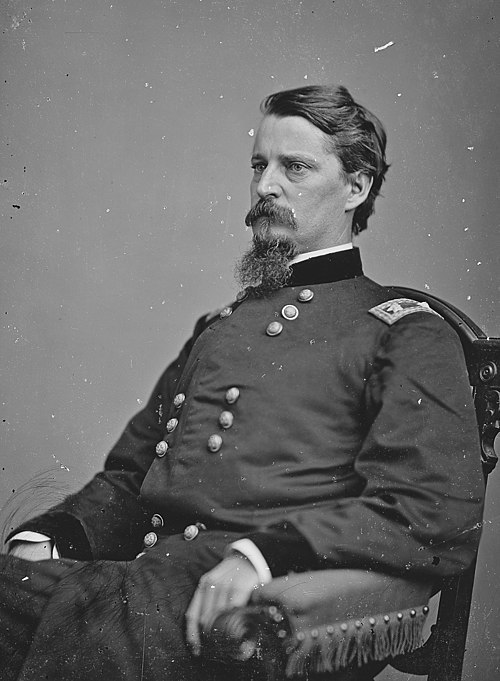
Image by
Unknown authorUnknown author or not provided
14th February 🗓️ : Holiday - Christian feast day: Cyril and Methodius, patron saints of Europe (Roman Catholic Church) "Cyril (born Constantine, 826–869) and Methodius (815–885) were brothers, Byzantine Christian theologians and missionaries. For their work evangelizing the Slavs, they are known as the "Apostles to the Slavs".They are credited with devising the Glagolitic alphabet, the first alphabet used to..."

Image by
painted by Zahari Zograf (Захарий Христович Димитров)
0 notes
Note
Sts. Cyril and Methodius?

Sts. Cyril and Methodius are Byzantine Saints who are also recognized by the Catholic church - they’re brothers who became monks together and became missionaries to the slavic peoples in Eastern Europe. Instead of trying to preach in Latin or Greek which were the established languages of the liturgy at the time, they learned the native languages and connected with people in the common vernacular, even going so far as to develop a whole new alphabet so that they could translate the Bible! What’s now known as the Cyrillic script is the base of several languages’ writing system, with variations used in Russian, Ukranian, Bulgarian, and Serbian among many many others.
They also worked closely with the Pope in Rome, helping to bride the gap between the Eastern and Western rites, and Methodius was named Archbishop which was a really big deal at the time with the many tensions between the two. They weren’t the first missionaries to the Slavic region but their work was the one that succeeded, which is part of why they’re so widely honored in those areas and depicted super often in iconography.
All Hallows Ask Game: Send me a number and I'll tell you about a saint!
18 notes
·
View notes
Text
Slavic Paganism
“Slavic paganism or Slavic religion describes the religious beliefs, myths and ritual practices of the Slavs before Christianisation, which occurred at various stages between the 8th and the 13th century. The South Slavs, who likely settled in the Balkan Peninsula during the 6th–7th centuries AD, bordering with the Byzantine Empire to the south, came under the sphere of influence of Eastern Orthodox Christianity, beginning with the creation of writing systems for Slavic languages (first Glagolitic, and then Cyrillic script) in 855 by the brothers Saints Cyril and Methodius and the adoption of Christianity in Bulgaria in 863. The East Slavs followed with the official adoption in 988 by Vladimir the Great of Kievan Rus'.”

“The West Slavs' process of christianization was more gradual and complicated. The Moravians accepted Christianity as early as 831, the Bohemian dukes followed in 845, but the Poles accepted it much later, in 966, around the same time as the Sorbs, and the Polabian Slavs only came under the significant influence of the Roman Catholic Church from the 12th century onwards. For them and the Sorbs, Christianisation went hand in hand with full or partial Germanisation.”

“The Christianisation of the Slavic peoples was, however, a slow and—in many cases—superficial phenomenon, especially in what is today Russia. Christianisation was vigorous in western and central parts of what is today Ukraine, since they were closer to the capital, Kyiv. Even there, however, popular resistance led by volkhvs, pagan priests or shamans, recurred periodically for centuries.”

“The West Slavs of the Baltic withstood tenaciously against Christianity until it was violently imposed on them through the Northern Crusades. Among Poles and East Slavs, rebellion outbreaks occurred throughout the 11th century. Christian chroniclers reported that the Slavs regularly re-embraced their original religion (relapsi sunt denuo ad paganismus).”

“Many elements of the indigenous Slavic religion were officially incorporated into Slavic Christianity (which manifested itself in the architecture of the Russian Church, icon painting, etc.), and, besides this, the worship of Slavic gods has persisted in unofficial folk religion until modern times. The Slavs' resistance to Christianity gave rise to a "whimsical syncretism" which in Old Church Slavonic vocabulary was defined as dvoeverie, "double faith". Since the early 20th century, Slavic folk religion has undergone an organised reinvention and reincorporation in the movement of Slavic Native Faith (Rodnovery).”

Slavic mythology is one of the more forgotten mythological beliefs, most of all the stories and records believed by these pagans a millennia ago have been destroyed and burned. Most of what is known has survived through oral folklore passed down as family stories and through multiple songs. The people that practiced slavic paganism have been discriminated and violated through many centuries now so I truly respect that they made this work with the limited information and lore they have saved, but it’s enough to create a perfect illusion of a vast, mythical world that follows its own rules and principles with spirits and deities not found anywhere else in the world.
https://en.wikipedia.org/wiki/Slavic_paganism
https://www.google.com/search?q=slavic+mythology&client=safari&rls=en&source=lnms&tbm=isch&sa=X&ved=2ahUKEwjU6MvNx6DvAhXQOcAKHazbDGsQ_AUoAXoECB4QAw&biw=1519&bih=912#imgrc=zuBBCH1wvmJN-M&imgdii=TnA35KSFEyLPMM
https://culture.pl/en/article/what-is-known-about-slavic-mythology
4 notes
·
View notes
Text
Today, the Church remembers Sts. Cyril, Priest and Monk, and Methodius, Bishop, both Missionaries.
Orate pro nobis.
Saints Cyril and Methodius (AD 826–869, 815–885) were two brothers who were Byzantine Christian theologians and Christian missionaries. Through their work they influenced the cultural development of all Slavs, for which they received the title "Apostles to the Slavs".
They are credited with devising the Glagolitic alphabet, the first alphabet used to transcribe Old Church Slavonic. After their deaths, their pupils continued their missionary work among other Slavs. Both brothers are venerated in the Orthodox Church as saints with the title of "equal-to-apostles". In 1880, Pope Leo XIII introduced their feast into the calendar of the Roman Catholic Church. In 1980, Pope John Paul II declared them co-patron saints of Europe, together with Benedict of Nursia.
The two brothers were born in Thessalonica (located in present-day Greece) – Cyril in about AD 827–828 and Methodius about 815–820. Cyril was reputedly the youngest of seven brothers; he was born Constantine, but was given the name Cyril upon becoming a monk in Rome shortly before his death, according to the Vita Cyrilli ("The Life of Cyril"). Methodius was born Michael and was given the name Methodius upon becoming a monk at Mysian Olympus (present-day Uludağ), in northwest Turkey. Their father was Leo, a droungarios of the Byzantine theme of Thessalonica, and their mother was Maria.
The exact ethnic origins of the brothers are unknown, there is controversy as to whether Cyril and Methodius were of Slavic or Byzantine Greek origin, or both. The two brothers lost their father when Cyril was fourteen, and the powerful minister Theoktistos, who was logothetes tou dromou, one of the chief ministers of the Empire, became their protector. He was also responsible, along with the regent Bardas, for initiating a far-reaching educational program within the Empire which culminated in the establishment of the University of Magnaura, where Cyril was to teach. Cyril was ordained as priest some time after his education, while his brother Methodius remained a deacon until AD 867/868.
About the year 860, Byzantine Emperor Michael III and the Patriarch of Constantinople Photius (a professor of Cyril's at the University and his guiding light in earlier years), sent Cyril on a missionary expedition to the Khazars who had requested a scholar be sent to them who could converse with both Jews and Saracens. After his return to Constantinople, Cyril assumed the role of professor of philosophy at the University while his brother had by this time become a significant player in Byzantine political and administrative affairs, and an abbot of his monastery.
In 862, the brothers began the work which would give them their historical importance. That year Prince Rastislav of Great Moravia requested that Emperor Michael III and the Patriarch Photius send missionaries to evangelize his Slavic subjects. His motives in doing so were probably more political than religious. Rastislav had become king with the support of the Frankish ruler Louis the German, but subsequently sought to assert his independence from the Franks. It is a common misconception that Cyril and Methodius were the first to bring Christianity to Moravia, but the letter from Rastislav to Michael III states clearly that Rastislav's people "had already rejected paganism and adhere to the Christian law." Rastislav is said to have expelled missionaries of the Roman Church and instead turned to Constantinople for ecclesiastical assistance and, presumably, a degree of political support. The Emperor quickly chose to send Cyril, accompanied by his brother Methodius. Their first work seems to have been the training of assistants. In AD 863, they began the task of translating the Bible into the language now known as Old Church Slavonic and travelled to Great Moravia to promote it. They enjoyed considerable success in this endeavour. However, they came into conflict with German ecclesiastics who opposed their efforts to create a specifically Slavic liturgy.
For the purpose of this mission, they devised the Glagolitic alphabet, the first alphabet to be used for Slavonic manuscripts. The Glagolitic alphabet was suited to match the specific features of the Slavic language. Its descendant script, the Cyrillic, is still used by many languages today.
The brothers wrote the first Slavic Civil Code, which was used in Great Moravia. The language derived from Old Church Slavonic, known as Church Slavonic, is still used in liturgy by several Orthodox Churches and also in some Eastern Catholic churches.
It is impossible to determine with certainty what portions of the Bible the brothers translated. The New Testament and the Psalms seem to have been the first, followed by other lessons from the Old Testament. The "Translatio" speaks only of a version of the Gospels by Cyril, and the "Vita Methodii" only of the "evangelium Slovenicum," though other liturgical selections may also have been translated.
The mission of Cyril and Methodius had great success among Slavs in part because they used the people's native language rather than Latin or Greek. In Great Moravia, Constantine and Methodius also encountered missionaries from East Francia, representing the western or Latin branch of the Church, and more particularly representing the Carolingian Empire as founded by Charlemagne, and committed to linguistic, and cultural uniformity. They insisted on the use of the Latin liturgy, and they regarded Moravia and the Slavic peoples as part of their rightful mission field.
When friction developed, the brothers, unwilling to be a cause of dissension among Christians, decided to travel to Rome to see the Pope, and seek a solution that would avoid quarreling between missionaries in the field. In 867, Pope Nicholas I (858-867) invited the brothers to Rome. Their evangelizing mission in Moravia had by this time become the focus of a dispute with Archbishop Adalwin of Salzburg (859–873) and Bishop Ermanrich of Passau (866-874), who claimed ecclesiastical control of the same territory and wished to see it use the Latin liturgy exclusively.
The brothers sought support from Rome, and arrived there in 868, where they were warmly received. This was partly due to their bringing with them the relics of Saint Clement; the rivalry with Constantinople as to the jurisdiction over the territory of the Slavs would incline Rome to value the brothers and their influence.
New Pope Adrian II (867-872) gave Methodius the title of Archbishop of Sirmium (now Sremska Mitrovica in Serbia) and sent him back in 869, with jurisdiction over all of Moravia and Pannonia, and authorisation to use the Slavonic Liturgy. The brothers were praised for their learning and cultivated for their influence in Constantinople. Anastasius Bibliothecarius would later call Cyril "a man of apostolic life" and "a man of great wisdom". Their project in Moravia found support from Pope Adrian II, who formally authorized the use of the new Slavic liturgy. Subsequently Methodius was ordained as priest by the pope himself, and five Slavic disciples were ordained as priests (Saint Gorazd, Saint Clement of Ohrid and Saint Naum) and as deacons (Saint Angelar and Saint Sava) by the prominent bishops Formosus and Gauderic. Cyril and Methodius along with these five disciples are collectively venerated (mainly by the Bulgarian Orthodox Church) as "Seven Saints". The newly made priests officiated in their own languages at the altars of some of the principal churches. Feeling his end approaching, Cyril became a Basilian monk, was given the new name Cyril, and died in Rome fifty days later (AD 14 February 869).
Methodist, by now an archbishop, dies on AD 6 April 885. After decades of missionary work by the brothers, translating the Holy Scriptures, they helped the Slavic peoples to remain linguistically, culturally, and ecclesiastically distinct during a period when they were pawns in the territorial rivalry between Constantinople and Rome. The Cyrillic alphabet gradually replaced Glagolitic as the alphabet of the Old Church Slavonic language, which became the official language of the Bulgarian Empire and later spread to the Eastern Slav lands of Kievan Rus'. Cyrillic eventually spread throughout most of the Slavic world to become the standard alphabet in the Eastern Orthodox Slavic countries. Hence, Cyril and Methodius' efforts also paved the way for the spread of Christianity throughout Eastern Europe.
Methodius' body was buried in the main cathedral church of Great Moravia.
Almighty and everlasting God, by the power of the Holy Spirit you moved your servant Cyril and his brother Methodius to bring the light of the Gospel to a hostile and divided people: Overcome all bitterness and strife among us by the love of Christ, and make us one united family under the banner of the Prince of Peace; who lives and reigns with you and the Holy Spirit, one God, now and for ever.
Amen.
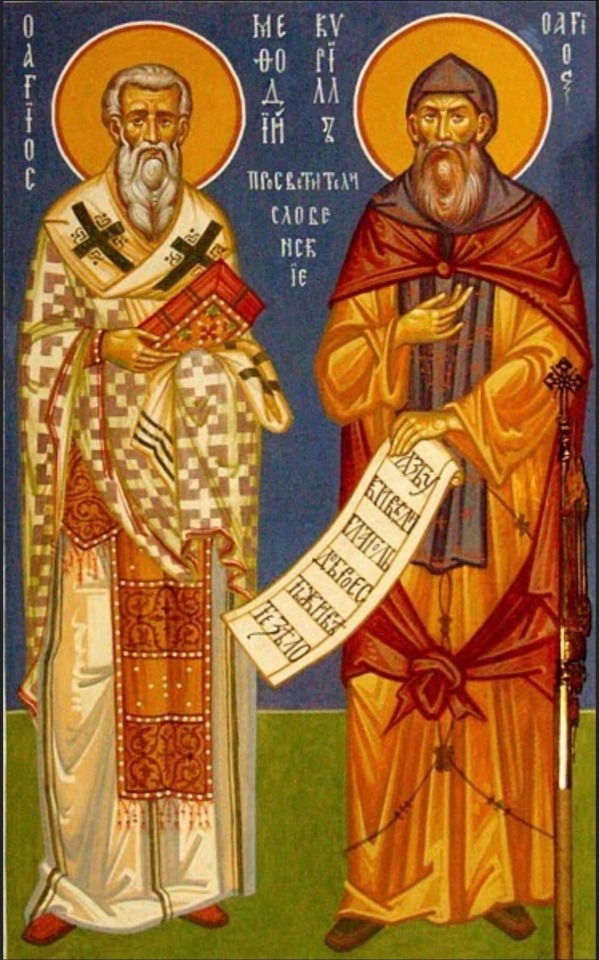
#father troy beecham#christianity#troy beecham episcopal#jesus#father troy beecham episcopal#saints#god#salvation
5 notes
·
View notes
Text
Saints Cyril and Methodius they introduced Christianity to Slovakian People
Cyril (conceived Constantine, 826–869) and Methodius (815–885) were two siblings and Byzantine Christian scholars and teachers. For their work evangelizing the Slavs, they are known as the "Witnesses to the Slavs".
They are credited with contriving the Glagolitic letters in order, the primary letter set used to translate Old Church Slavonic. After their demises, their students proceeded with their minister work among different Slavs. The two siblings are loved in the Orthodox Church as holy people with the title of "equivalent to-messengers". In 1880, Pope Leo XIII brought their banquet into the schedule of the Roman Catholic Church. In 1980, Pope John Paul II pronounced them co-benefactor holy people of Europe, together with Benedict of Nursia.
In 862, the siblings started the work which would give them their chronicled significance. That year Prince Rastislav of Great Moravia mentioned that Emperor Michael III and the Patriarch Photius send ministers to proselytize his Slavic subjects. His thought processes in doing so were most likely more political than strict. Rastislav had become lord with the help of the Frankish ruler Louis the German, however in this manner looked to state his autonomy from the Franks.
It is a typical confusion that Cyril and Methodius were the first to carry Christianity to Moravia, yet the letter from Rastislav to Michael III states unmistakably that Rastislav's kin "had just dismissed agnosticism and cling to the Christian law."[19] Rastislav is said to have removed evangelists of the Roman Church and rather went to Constantinople for clerical help and, apparently, a level of political help. The Emperor immediately decided to send Cyril, joined by his sibling Methodius. The solicitation gave an advantageous chance to grow Byzantine impact. Their first work appears to have been the preparation of colleagues. In 863, they started the assignment of making an interpretation of the Bible into the language presently known as Old Church Slavonic and made a trip to Great Moravia to advance it. They delighted in extensive achievement in this undertaking. In any case, they clashed with German ministers who restricted their endeavors to make an explicitly Slavic ceremony.
With the end goal of this crucial, conceived the Glagolitic letters in order, the main letter set to be utilized for Slavonic compositions. The Glagolitic letter set was fit to coordinate the particular highlights of the Slavic language. Its relative content, the Cyrillic, is as yet utilized by numerous dialects today. The siblings composed the primary Slavic Civil Code, which was utilized in Great Moravia. The language got from Old Church Slavonic, known as Church Slavonic, is as yet utilized in ceremony by a few Orthodox Churches and furthermore in some Eastern Catholic places of worship.
It is difficult to decide with assurance what bits of the Bible the siblings deciphered. The New Testament and the Psalms appear to have been the first, trailed by different exercises from the Old Testament. The "Translatio" talks just of a rendition of the Gospels by Cyril, and the "Vita Methodii" just of the "Evangelium Slovenicum," however other ritualistic choices may likewise have been interpreted.
Nor is it known without a doubt which ritual, that of Rome or that of Constantinople, they took as a source. They may well have utilized the Roman letters in order, as proposed by ritualistic pieces which cling near the Latin sort. This view is affirmed by the "Prague Fragments" and by certain Old Glagolitic formal pieces brought from Jerusalem to Kyiv and found there by Izmail Sreznevsky—most likely the most seasoned record for the Slavonic tongue; these cling near the Latin kind, as is appeared by the words "Mass," "Prelude," and the name of one Felicitas. Regardless, the conditions were to such an extent that the siblings could seek after no perpetual accomplishment without getting the approval of Rome.
https://world-wide-superpobyt-travel.blogspot.com/
#SuperPobytTravel#WorldWideTravel#LastMinuteTravel#TravelToSlovakia#HistoryOfSlovakia#GreatMoraviaMission
1 note
·
View note
Text


7th May >> (@ZenitEnglish By Deborah Castellano Lubov) #PopeFrancis #Pope Francis: ‘You Are Rightly Proud of This Great Woman,’ Pope Francis Tells Authorities in Birth Country of St Mother Teresa. Pope Francis Underscores to Civil Authorities & Diplomatic Corps That This Marks ‘1st Time Successor of Apostle Peter Has Come to Republic of North Macedonia’ (Full Text)
‘You are rightly proud of this great woman.’
Pope Francis stressed this during his one day visit to North Macedonia, on May 7, 2019, when addressing members of the diplomatic corps and civil authorities, in Skopje, the city of birth of Saint Mother Teresa, during his apostolic journey to Bulgaria and North Macedonia 5th - 7th May 2019.
Today’s one day visit to North Macedonia, marks the first visit ever by a Roman Pontiff to the country, where Mother Teresa was born.
In this context, Francis said he wished “to pay homage in a very special way to one of your illustrious fellow-citizens, who, moved by the love of God, made love of neighbour the supreme law of her life,” who “won the admiration of the whole world and pioneered a specific and radical way of devoting one’s life to the service of the abandoned, the discarded, and the poorest of the poor.”
“I am naturally referring to the woman universally known as Mother Teresa of Calcutta,” he stated. Born in 1910 in a suburb of Skopje with the name of Anjezë Gonxha Bojaxhiu, Francis recalled that she carried out her apostolate of humble and complete self-giving in India and, through her Sisters, reached out to the most varied geographical and existential peripheries.
The Holy Father expressed his delight in being able to, today, to be able to pause in prayer at the memorial dedicated to her, built on the site of the Church of the Sacred Heart, where she was baptized.
“You are rightly proud of this great woman. I urge you to continue to work in a spirit of commitment, dedication and hope, so that the sons and daughters of this land, following her example, can recognize, attain and fully develop the vocation that God has envisaged for them.”
Historic 1st
“This is the first time that the Successor of the Apostle Peter has come to the Republic of North Macedonia,” Pope Francis also said, saying he was happy to do so on the 25th anniversary of the establishment of diplomatic relations with the Holy See, which occurred a few years after the country became independent in September 1991.
Pope Francis concluded, praying: “May God protect and bless North Macedonia, preserve it in concord, and grant it prosperity and joy!”
Below is the Vatican-provided full text of the Pope’s address:
***
Mr President,
Mr Prime Minister,
Honourable Members of the Diplomatic Corps,
Distinguished Civil and Religious Authorities,
Dear Brothers and Sisters,
I am very grateful to the President for his kind words of welcome and for the gracious invitation to visit North Macedonia that he, together with the Prime Minister, extended to me.
I also thank the representatives of the other religious communities present among us. I offer a warm greeting to the Catholic community, represented here by the Bishop of Skopje and Eparch of the Eparchy of Blessed Virgin Mary of the Assumption in Strumica-Skopje, which is an active and integral part of your society, sharing fully in the joys, concerns and daily life of your people.
This is the first time that the Successor of the Apostle Peter has come to the Republic of North Macedonia. I am happy to do so on the twenty-fifth anniversary of the establishment of diplomatic relations with the Holy See, which occurred a few years after the country became independent in September 1991.
Your land, a bridge between East and West and a meeting-point for numerous cultural currents, embodies many of the distinctive marks of this region. With the elegant testimonies of its Byzantine and Ottoman past, its lofty mountain fortresses and the splendid iconostases of its ancient churches, which speak of a Christian presence dating back to apostolic times, North Macedonia reflects all the depth and richness of its millennial culture. But allow me to say that these great cultural treasures are themselves only a reflection of your more precious patrimony: the multiethnic and multi-religious countenance of your people, the legacy of a rich and, indeed, complex history of relationships forged over the course of centuries.
This crucible of cultures and ethnic and religious identities has resulted in a peaceful and enduring coexistence in which those individual identities have found expression and developed without rejecting, dominating or discriminating against others. They have thus given rise to a fabric of relationships and interactions that can serve as an example and a point of reference for a serene and fraternal communal life marked by diversity and reciprocal respect.
These particular features are also highly significant for increased integration with the nations of Europe. It is my hope that this integration will develop in a way that is beneficial for the entire region of the Western Balkans, with unfailing respect for diversity and for fundamental rights.
Here, in fact, the different religious identities of Orthodox, Catholics, other Christians, Muslims and Jews, and the ethnic differences between Macedonians, Albanians, Serbs, Croats, and persons of other backgrounds, have created a mosaic in which every piece is essential for the uniqueness and beauty of the whole. That beauty will become all the more evident to the extent that you succeed in passing it on and planting it in the hearts of the coming generation.
Every effort made to enable the diverse religious expressions and the different ethnic groups to find a common ground of understanding and respect for the dignity of every human person, and consequently the guarantee of fundamental freedoms, will surely prove fruitful. Indeed, those efforts will serve as the necessary seedbed for a future of peace and prosperity.
I would also like to acknowledge the generous efforts made by your Republic – both by the State authorities themselves and with the valued contribution of various international Agencies, the Red Cross, Caritas and several non-governmental organizations – to welcome and provide assistance to the great number of migrants and refugees coming from different Middle Eastern countries. Fleeing from war or from conditions of dire poverty often caused precisely by grave outbreaks of violence, in the years 2015 and 2016, they crossed your borders, headed for the most part towards northern and western Europe. With you, they found a secure haven. The ready solidarity offered to those in such great need – people who had left behind so many of their dear ones, to say nothing of their homes, their work and their homeland – does you honour. It says something about the soul of this people that, having itself experienced great privations, you recognize in solidarity and in the sharing of goods the route to all authentic development. It is my hope that you will cherish the chain of solidarity that emerged from that emergency, and thus support all volunteer efforts to meet the many different forms of hardship and need.
I wish likewise to pay homage in a very special way to one of your illustrious fellow-citizens, who, moved by the love of God, made love of neighbour the supreme law of her life. She won the admiration of the whole world and pioneered a specific and radical way of devoting one’s life to the service of the abandoned, the discarded, and the poorest of the poor. I am naturally referring to the woman universally known as Mother Teresa of Calcutta. Born in 1910 in a suburb of Skopje with the name of Anjezë Gonxha Bojaxhiu, she carried out her apostolate of humble and complete self-giving in India and, through her Sisters, reached out to the most varied geographical and existential peripheries. I am pleased that I will shortly be able to pause in prayer at the Memorial dedicated to her, built on the site of the Church of the Sacred Heart, where she was baptized.
You are rightly proud of this great woman. I urge you to continue to work in a spirit of commitment, dedication and hope, so that the sons and daughters of this land, following her example, can recognize, attain and fully develop the vocation that God has envisaged for them.
Mr President,
From the time that North Macedonia gained its independence, the Holy See has closely followed the steps that this country has taken to advance dialogue and understanding between the civil authorities and religious confessions.
Today, God’s providence offers me the chance to demonstrate personally this closeness and to express gratitude as well for the yearly visit made to the Vatican by an official Delegation of yours on the feast of Saints Cyril and Methodius. I encourage you to persevere with confidence along the path you have taken, in order to make your country a beacon of peace, acceptance and fruitful integration between cultures, religions and peoples. Drawing from their respective identities and the vitality of their cultural and civil life, they will thus be able to build a common destiny in openness to the enrichment that each has to offer.
May God protect and bless North Macedonia, preserve it in concord, and grant it prosperity and joy!
© Libreria Editrice Vatican
7th MAY 2019 11:34PAPAL TRIPS
1 note
·
View note
Photo

Sts Cyril (827-869) & Methodius (826-885) Bishops, Confessors, Theologians, Missionaries, Writers, Preachers, Patrons of Europe, Apostles to the Slavs. Sts Cyril & Methodius were two brothers who were Byzantine Christian theologians and Christian missionaries. Through their work they influenced the cultural development of all Slavs, for which they received the title “Apostles to the Slavs”. They are credited with devising the Glagolitic alphabet, the first alphabet used to transcribe Old Church Slavonic. After their deaths, their pupils continued their missionary work among other Slavs. In 1880, Pope Leo XIII introduced their feast into the calendar of the Roman Catholic Church. In 1980, St Pope John Paul II declared them co-patron saints of Europe, together with Benedict of Nursia. https://www.instagram.com/p/CZ9d_mMrOR6/?utm_medium=tumblr
0 notes
Photo

THE DESCRIPTION OF SAINTS CYRIL AND METHODIUS The Apostles to the Slavs Feast Day: February 14
"However, tired and physically worn out I am, I will go with joy to that land; with joy I depart for the sake of the Christian faith." -Cyril
Cyril and Methodius were two brothers, natives of Thessalonica in Greece. Their father was Leo, a droungarios of the Byzantine theme of Thessalonica, and their mother was Maria. The two brothers lost their father when Cyril was fourteen, and the powerful minister Theoktistos, who was logothetes tou dromou, one of the chief ministers of the Empire, became their protector.
Cyril studied at Constantinople and was ordained a priest at an early age. Methodius, his elder brother, abandoned a promising political career to become a monk.
In the year 863, the patriarch of Constantinople sent them as missionaries to Moravia. Their first task was to translate the Slav language into written characters, which were called Cyrillic, which they used in their preaching and apostolate. The brothers also wrote the first Slavic Civil Code, which was used in Great Moravia. The language derived from Old Church Slavonic, known as Church Slavonic, is still used in liturgy by several Orthodox Churches and also in some Eastern Catholic churches. They soon converted many people to Christianity, but they had to face those clergy who opposed the use of Slavonic in liturgy, and the lack of a bishop to ordain more priests. When they came to Rome to render an account of their mission, there were consecrated as bishops by Pope Adrian II.
In 869, Cyril died in Rome, leaving Methodius alone to continue the evangelization of Moravia, Bohemia, Poland and the neighboring countries. Eventually, Methodius was arrested by a group of German bishops who did not like the use of the Slavonic language in liturgy, on the grounds that it was a barbarous language. Pope John VIII had him released two years later, and withdrew the permission to use the Slavonic language except for preaching. During the last years of his life, Methodius completed the Slavic translation of the Holy Bible. He died in 884, and was buried with his brother in the church of St. Clement in Rome.
1 note
·
View note
Photo

St. Nicholas of Myra Patron Saint of Brides Feast Day: December 6th (Both Calendars) __________
The great veneration with which St. Nicholas has been honored for many ages and the number of altars and churches all over the world that are dedicated in his memory are testimonials to his wonderful holiness and the glory he enjoys with God. As an episcopal see, and his childhood church falling vacant, the holy Nicholas was chosen bishop, and in that station became famous by his extraordinary piety and zeal and by his many astonishing miracles. The Greek histories of his life agree he suffered an imprisonment of the faith and made a glorious confession in the latter part of the persecution raised by Dioletian, and that he was present at the Council of Nicaea and there condemned Arianism. It is said that St. Nicholas died in Myra, and was buried in his cathedral.
St. Nicholas' episcopate at Myra during the fourth century is really all that appears indubitable authentic, according to Alban Butler, an English Roman Catholic priest from the 1700s. This is not for lack of material, beginning with the life attributed to the monk who died in 847 as St. Methodius, Patriarch of Constantinople. Nevertheless, the universal popularity of the saint for so many centuries requires that some account of the legends surrounding his life should be given.
St. Nicholas, also known as "Nikolaos of Myra," was a fourth century saint and Greek bishop of Myra. Nicholas was born in Asia Minor in the Roman Empire as an only child to Christian parents. Nicholas would take nourishment only once on Wednesdays and Fridays, and that in the evening according to the canons. "He was exceedingly well brought up by his parents and trod piously in their footsteps. The child, watched over by the church, enlightened his mind and encouraged his thirst for sincere and true religion." Both of his parents tragically died during an epidemic when he was a young man, leaving him well off, but to be raised by his uncle - the Bishop of Patara. Nicholas was determined to devote his inheritance to works of charity, and his uncle mentored him as a reader and later ordained him as a presbyter (priest).
An opportunity soon arose for St. Nicholas and his inheritance. A citizen of Patara had lost all his money, and needed to support his three daughters who could not find husbands because of their poverty; so the wretched man was going to give them over to prostitution. Nicholas became informed of this, and thus took a bag of gold and threw it into an open window of the man's house in the night. Here was a dowry for the eldest girl and she was soon duly married. At intervals Nicholas did the same for the second and the third; at the last time the father was on the watch, recognized his benefactor and overwhelmed Nicholas with his gratitude. It would appear that the three purses represented in pictures, came to be mistaken for the heads of three children and so they gave rise to the absurdstory of the children, resuscitated by the saint, who had been killed by an innkeeper and pickled in a brine-tub.
Coming to the city of Myra when the clergy and people of the province were in session to elect a new bishop, St. Nicholas was indicated by God as the man they should choose. This was during the time of persecutions in the beginning of the fourth century and "as he [Nicholas] was the chief priest of the Christians of this town and preached the truths of faith with a holy liberty, the divine Nicholas was seized by the magistrates, tortured, then chained and thrown into prison with many other Christians. But when the great and religious Constatine, chosen by God, assumed the imperial diadem of the Romans, the prisoners were released from their bonds and with them the illustrious Nicholas, who when he was set at liberty returned to Myra."
St. Methodius asserts that "thanks to the teaching of St. Nicholas the metropolis of Myra alone was untouched by the filth of the Arian heresy, which it firmly rejected as death-dealing poison," but says nothing of his presence at the Council of Nicaea in 325.
According to other traditions St. Nicholas was not only there during the Council of Nicaea in 325, but so far forgot himself as to give the heresiarch Arius a slap in the face. The conciliar fathers deprived him of his episcopal insignia and committed him to prison; but our Lord and His Mother appeared there and restored to him both his liberty and his office.
As against Arianism so against paganism, St. Nicholas was tireless and often took strong measures: among other temples he destroyed was that of Artemis, the principal in the district, and the evil spirits fled howling before him. He was the guardian of his people as well in temporal affairs. The governor Eustathius had taken a bribe to condemn to death three innocent men. At the time fixed for their execution Nicholas came to the place, stayed the hands of the executioner, and released the prisoners. Then he turned to Eustathiujs and did not cease to reproach him until he admitted his crime and expressed his penitence.
St. Nicholas' presence was found in a separate occasion involving three imperial officers simply on their way to duty in Phrygia. When the men were back again in Constantinople, the jealousy of the prefect Ablavius caused them to be imprisoned on false charges and an order for their death was procured from the Emperor Constantine. When the officers heard this they remembered the example they had witnessed of the powerful love of justice of the Bishop of Myra and they prayed to God that through his merits and by his instrumentality they might yet be saved. That night St. Nicholas appeared in a dream to Constatine, and told him with threats to release the three innocent men, and Ablavius experienced the same thing. In the morning the Emporor and the prefect compared notes, and the condemned men were sent for and questioned. When he heard they had called on the name of the Nicholas of Myra who appeared to him, Constatine set them free and sent them to the bishop with a letter asking him not to threaten him any more, but to pray for the peace of the world. For a long time, this has been the most famous miracle of St. Nicholas, and at the time of St. Methodius was the only thing generally known about him.
The accounts are unanimous that St. Nicholas died and was buried in his episcopal city of Myra, and by the time of Justinian, there was a basilica built in his honor at Constantinople.
An anonymous Greek wrote in the tenth century that, "the West as well as the East acclaims and glorifies him. Wherever there are people, in the country and the town, in the villages, in the isles, in the furthest parts of the earth, his name is revered and churches are built in his honor. Images of him are set up, panegyrics preached and festivals celebrated. All Christians, young and old, men and women, boys and girls, reverence his memory and call upon his protection. And his favors, which know no limit of time and continue from age to age, are poured out over all the earth; the Scythians know them, as do the Indians and the barbarians, the Africans as well as the Italians." When Myra and its great shrine finally passed into the hands of the Saracens, several Italian cities saw this as an opportunity to acquire the relics of St. Nicholas for themselves. There was great competition for them between Venice and Bari.
Bari won and the relics were carried off under the noses of the lawful Greek custodians and their Mohammedan masters. On May 9, 1087 St. Nicholas' relics safetly landed in Bari, a not inappropriate home seeing that Apulia in those days still had large Greek colonies. A new church was built to shelter the relics and the pope, Bd. Urban II, was present at their enshrining.
Devotion to St. Nicholas has been present in the West long before his relics were brought to Italy, but this happening greatly increased his veneration among the people, and miracles were as freely attributed to his intercession in Europe as they had been in Asia. At Myra "the venerable body of the bishop, embalmed as it was in the good ointments of virtue exuded a sweet smelling myrrh, which kept it from corruption and proved a health giving remedy against sickness to the glory o f him who had glorified Jesus Christ, our true God." The translation of the relics did not interrupt this phenomenon, and the "manna of St. Nicholas" is said to flow to this day. It was one of the great attractions that drew pilgrims to his tomb from all parts of Europe.
The image of St. Nicholas is, more often than any other, found on Byzantine seals. In the later middle ages nearly four hundred churches were dedicated in his honor in England alone, and he is said to have been represented by Christian artists more frequently than any saint, except our Lady.
St. Nicholas is celebrated as the patron saint of several classes of people, especially, in the East, of sailors and in the West of children. The first of these patronage is most likely due to the legend that during his lifetime, he appeared to storm tossed mariners who invoked his aid off the coast of Lycia and brought them safely to port. Sailors in the Aegean and Ionian seas, following a common Eastern custom, had their "star of St. Nicholas" and wished one another a good voyage in the phrase "May St. Nicholas hold the tiller."
The legend of the "three children" is credited to his patronage of children and various observances, ecclesiastical and secular, connected there with; such were the boy bishop and especially in Germany, Switzerland and the Netherlands, the giving of presents in his name at Christmas time.
This custom in England is not a survival from Catholic times. It was popularized in America by the Dutch Protestants of New Amsterdam who converted the popish saint into a Nordic magician (Santa Claus = Sint Klaes = Saint Nicholas) and was introduced into this country by Bret Harte. It is not the only "good old English custom" which, however good, is not "old English," at any rate in its present form. The deliverance of the three imperial officers naturally caused St. Nicholas to be invoked by and on behalf of prisoners and captives, and many miracles of his intervention are recorded in the middle ages.
Curiously enough, the greatest popularity of St. Nicholas is found neither in the eastern Mediterranean nor north-western Europe, great as that was, but in Russia. With St. Andred the Apostle, he is patron of the nation, and the Russian Orthodox Church even observes the feast of his translation; so many Russian pilgrims came to Bari before the revolution that their government supported a church, hospital and hospice there.
He is also the patron saint of Greece, Apulia, Sicily and Loraine, and of many citiesand dioceses (including Galway) and churches innumerable. At Rome the basilica of St. Nicholas in the Jail of Tully (in Carcere) was founded between the end of the sixth and the beginning of the seventh centuries. He is named in the preparation of the Byzantine Mass. St. Nicholas became recognized as a saint long before the Roman Catholic Church began the regular canonizing procedures in the late 10th century. Therefore, he does not have a specific date of canonization, rather records of him exist in a gradual spread until his stories became widley known and celebrated. St. Nicholas' feast day is December 6.
1 note
·
View note
Photo
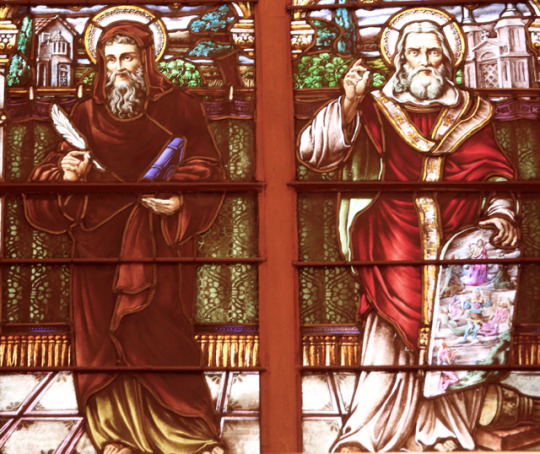


Saints of the Day – 14 February – Sts Cyril (827-869) & Methodius (826-885) Bishops, Confessors, Theologians, Missionaries, Writers, Preachers, Patrons of Europe, Apostles to the Slavs. Sts Cyril & Methodius were two brothers who were Byzantine Christian theologians and Christian missionaries. Through their work they influenced the cultural development of all Slavs, for which they received the title “Apostles to the Slavs”. They are credited with devising the Glagolitic alphabet, the first alphabet used to transcribe Old Church Slavonic. After their deaths, their pupils continued their missionary work among other Slavs. In 1880, Pope Leo XIII introduced their feast into the calendar of the Roman Catholic Church. In 1980, St Pope John Paul II declared them co-patron saints of Europe, together with Benedict of Nursia.
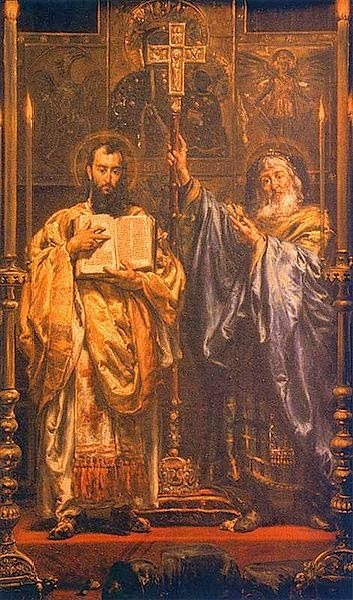
St Cyril’s Patronages – against storms, ecumenism, Slavic peoples (given in 1863 by Pope Pius IX), unity of the Eastern and Western Churches, Bohemia, Bosnia, Bosnia-Herzegovina, Bulgaria, Carinthia, Austria, Carniola, Circassia, Croatia, Czech Republic, Czechoslovakia, Dacia, Dalmatia, Europe (given in 1980 by St Pope John Paul II), Khazaria, Krain, Krajna, Kranjska, Moravia, Pannonia, Russia, Silesia, Slovenia, Yugoslavia, Ljubljana, Slovenia, archdiocese of, Maribor, Slovenia, archdiocese of, Saints Cyril and Methodius of Toronto, Ontario, diocese of. St Methodius’s Patronages – against storms, ecumenism, Slavic peoples (given in 1863 by Pope Pius IX), unity of the Eastern and Western Churches, Bohemia, Bosnia, Bosnia-Herzegovina, Bulgaria, Carinthia, Austria, Carniola, Circassia, Croatia, Czech Republic, Czechoslovakia, Dacia, Dalmatia, Europe (given in 1980 by St Pope John Paul II), Khazaria, Krain, Krajna, Kranjska, Moravia, Pannonia, Russia, Silesia, Slovenia, Yugoslavia, Ljubljana, Slovenia, archdiocese of, Maribor, Slovenia, archdiocese of, Saints Cyril and Methodius of Toronto, Ontario, diocese of.
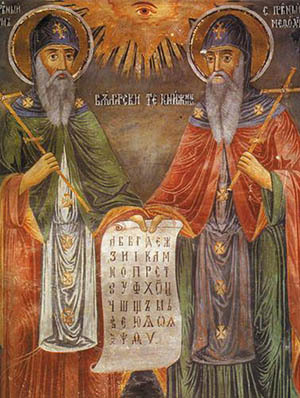
Methodius and Cyril (born Constantine) were born into a prominent Christian family in Thessalonica. As the area in which they were raised was a popular spot for Slavic people to settle in, traditions tells us that the holy brothers grew up familiar with the Slavic language (Slavonic). While we know their father was a prominent officer in the army, little is known of their young lives. History has recorded that Methodius, the elder brother, rose to the position of an important civil authority, who likely dealt in law and trade. His brother, Cyril, was trained as a scholar, professor and philosopher who gained renown in Constantinople.
After some years in public service, Methodius grew tired of worldly affairs and retired, seeking out solace and contemplation in a monastery. Eventually, Cyril joined him there, refusing a district to govern, preferring quiet devotion to the Lord. Together they lived in peace until the Byzantine emperor, having received a request for missionaries by the Moravian prince Rastislav, sent the brothers as missionaries to modern-day Ukraine. Being familiar with the language and well-acquainted with administration and politics, they were the perfect choice for such a mission. And given Rastislav’s desire for independence from Germany, Eastern missionaries (such as Methodius and Cyril) could help him gain independence over Church affairs.

Cyril and Methodius firmly believed that the Liturgy should be celebrated in the native language of the people, for greater inclusion in the Mass—a tradition which continues today. At that time, many were committed to only celebrating Mass in Greek or Latin, but these holy brothers dedicated themselves to proving otherwise. Prior to their departure for Moravia, they created a script for Slavonic (which had not previously existed). Known as Glagolithic, this written script is considered the precursor to Cyrillic (named after Saint Cyril). The creation of this script would allow the translation of Scripture and Liturgy into the language of the people.
Upon their arrival, Cyril immediately began translating the Liturgy into Slavonic. This created anxiety in the German priests, who saw the use of language as the next step to Slavic independence, and they actively worked against the translation. As neither Cyril nor Methodius was ordained a bishop, they travelled to Rome with their candidates for the priesthood to see the pope. After an audience, the pope approved the use of the Slavonic language in services, ordaining the local priests and securing the presence of Catholicism in the region.
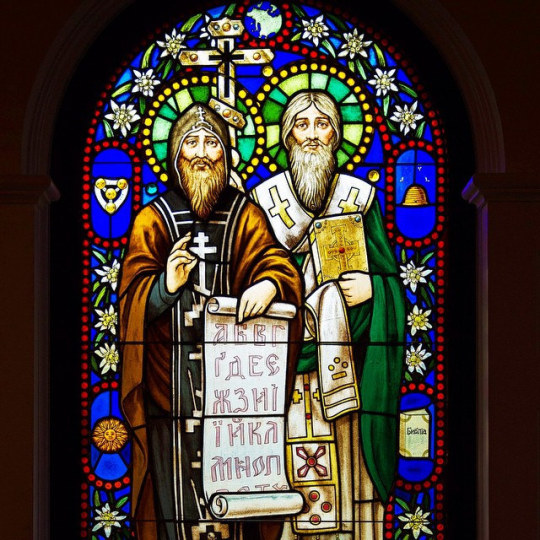
Sadly, Constantine never returned to Moravia. He entered the monastery, taking the name Cyril and not long after died. Methodius was stricken with grief and wished for nothing more than live the remainder of his days in the monastery but honoured a promise made to his brother and returned to finish their missionary work. Due to the political upheaval in Moravia, he was forbidden to return there. However, upon his ordination as bishop, he was invited to modern-day Serbia and Croatia, where he assumed the bishopric of Sirmium. There he continued to say Mass and administer baptisms in the native, Slavonic tongue.
Again, falling victim to the anxiety of the German priests and bishops, Saint Methodius was imprisoned and only released following Moravian independence from German and intervention from the pope. Again, Methodius traveled to Rome, meeting with the Pope, and explaining how important it was to celebrate the Liturgy in the tongue people understood. Instead of condemning him, as the German bishops had hoped, the pope gave him permission to use Slavonic in the Mass, in Scripture reading and in the office. He also made him head of the hierarchy in Moravia.
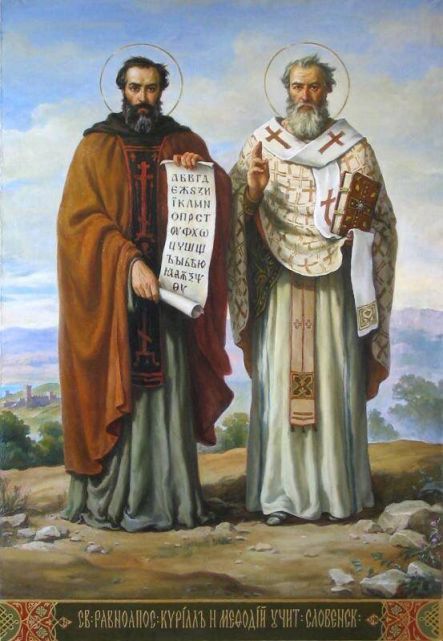
Saint Methodius, despite constant criticism and backlash, never stopped translating. It is said that he had translated the Bible and the works of the Church Fathers into Slavonic before his death.
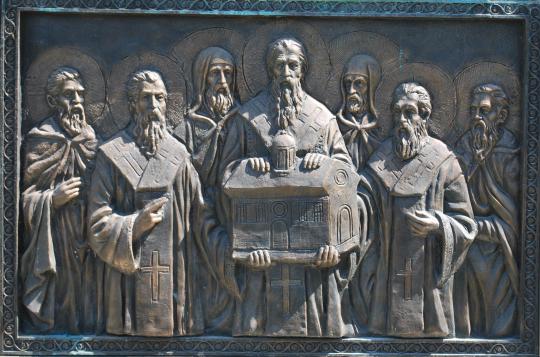
Memorial Monument to Sts Cyril & Methodius in Skopje

(via AnaStpaul – Breathing Catholic)
42 notes
·
View notes
Text

SAINTS FOR JULY 23
Sts. Rasyphus and Ravennus, 5th century. Martyrs. They came from Britain, fleeing the islands upon the invasions by the Anglo Saxons. Settling in Gaul, they became hermits and were martyred, perhaps by Arian Goths who were advancing through the West. Their relics are enshrined in the cathedral of Bayeux.
Martyrs of Bulgaria, Roman Catholic Martyrs caught in the war between the Byzantine Empire and the pagan Bulgars. Many were slain in battle, while others were put to death for the faith. Feastday July 23
Saint John Cassian (c. 360 – 435 AD), John the Ascetic, or John Cassian the Roman was a Christian monk and theologian celebrated in both the Western and Eastern Churches for his mystical writings. Cassian is noted for his role in bringing the ideas and practices of Christian monasticism to the early medieval West. Feastday July 23
ST. BRIDGET, RELIGIOUS, PATRON OF EUROPE (1303 – 23 July 1373); born as Birgitta Birgersdotter, was a mystic and saint, and founder of the Bridgettines nuns and monks after the death of her husband of twenty years. Outside of Sweden, she was also known as the Princess of Nericia[1] and was the mother of Catherine of Vadstena. She is one of the six patron saints of Europe, together with Benedict of Nursia, Saints Cyril and Methodius, Catherine of Siena and Edith Stein. Feastday July 23
0 notes
Text

St. Cyril and St. Methodius Byzantine Rite Catholic Church, Girard, Pennsylvania, USA (2009)
0 notes
Note
Oh that sounds interesting ! 20
Thank you! I hope you enjoy their story!
Sts. Cyril and Methodius are Byzantine Saints who are also recognized by the Catholic church - they’re brothers who became monks together and became missionaries to the slavic peoples in Eastern Europe. Instead of trying to preach in Latin or Greek which were the established languages of the liturgy at the time, they learned the native languages and connected with people in the common vernacular, even going so far as to develop a whole new alphabet so that they could translate the Bible! What’s now known as the Cyrillic script is the base of several languages’ writing system, with variations used in Russian, Ukranian, Bulgarian, and Serbian among many many others.
They also worked closely with the Pope in Rome, helping to bride the gap between the Eastern and Western rites, and Methodius was named Archbishop which was a really big deal at the time with the many tensions between the two. They weren’t the first missionaries to the Slavic region but their work was the one that succeeded, which is part of why they’re so widely honored in those areas and depicted super often in iconography.

Celebrate All Saints and All Souls with me
2 notes
·
View notes
Photo




Αναπαύσου εν ειρήνη, St. Cyril. A monk of either Slavic or Byzantine Greek origin, Cyril (born Constantine) and his brother Methodius (born Michael) are attributed with developing/inventing the Glagolitic Alphabet, the earliest form of what’s called Old Church Slavonic and the first attempt to write the early Slavic languages. Their philological (and theological) disciples used those early letters to develop what came to be called Cyrillic, so-named after Saint Cyril the Philosopher, and which is still used today as the national script of Belarus, Bosnia and Herzegovina, Bulgaria, Kazakhstan, Kyrgyzstan, Macedonia, Mongolia, Montenegro, Russia, Serbia, Tajikistan, and Ukraine. Today is the (Catholic, Anglican, and Lutheran) feast day of Saints Cyril and Methodius in honor of St. Cyril’s death on this date in 869.
Stamp details: Top left: Issued on: May 17, 1970 From: Athens, Greece MC #1046
Top middle: Issued on: October 22, 1985 From: Sofia, Bulgaria MC #3402
Top right: Issued on: November 22, 1963 From: Vatican City, Vatican City State MC #436
Stamp on bottom: Issued on: April 6, 2003 From: Bratislava, Slovakia MC #449
#saint cyril#st. cyril#greece#bulgaria#vatican city#slovakia#stamps#saints#cyrillic#orthodox saint#philately#february 14#Κύριλλος#Άγιοι Κύριλλος#slavic alphabet#glagolitic#language#philology#byzantine empire#old church slavonic#saint cyril the philosopher#Ελλάδα#България#Slovensko
7 notes
·
View notes